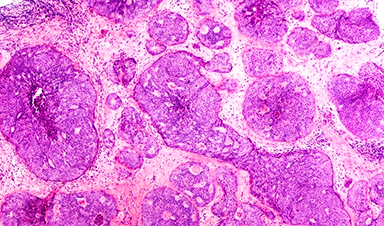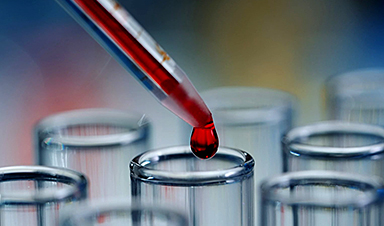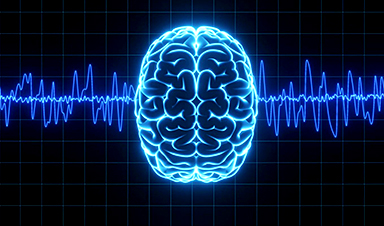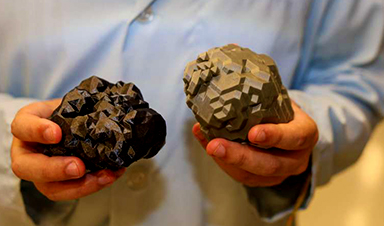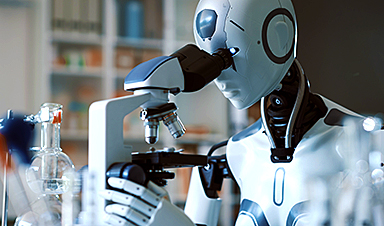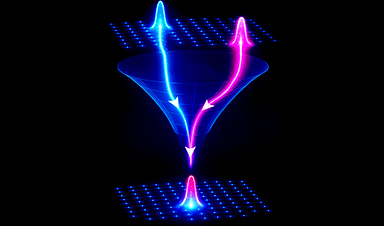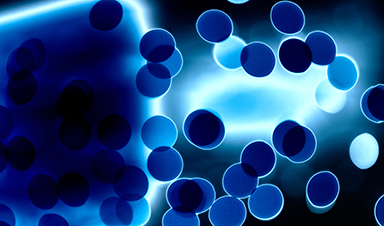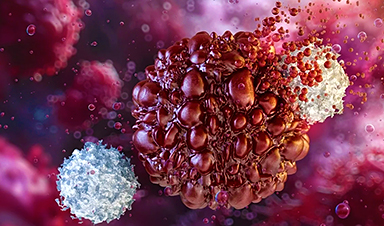In an article recently published in the open-access MDPI journal nanomaterials, researchers investigated the mechanism of interaction between nanoscale materials and specific cells for biomedical applications, primarily related to targeted delivery and tracing.
Here, the localization, cellular uptake quantity, and response time of gold nanorods in MCF-7 and SKBR-3 breast cancer cells were measured.
Background
The amalgamation of biotechnology and nanotechnology has been a quite fascinating field of research for the last few years.
Currently, nanomaterials are extensively used in biomedical applications such as drug delivery, magnetic or fluorescent bio-imaging, tissue engineering, tracing pathogens in sensitive organs, cancer chemotherapy, and many more. However, each nanomaterial interacts differently with a particular type of cell.
Many studies have shown cellular uptake of gold nanorods by cancer cells. MCF-7 and SKBR-3 cancer cell lines represent HER2-negative and HER2-positive breast cancer models, respectively. These cells intake gold nanorods through a mechanism occurring at the surface of the cell membrane, called endocytosis.
Inductively coupled plasma mass spectrometry (ICP-MS) can measure the efficiency of targeted delivery and cellular uptake of these nanoparticles, while transmission electron microscopy (TEM) can be used to investigate their localization.
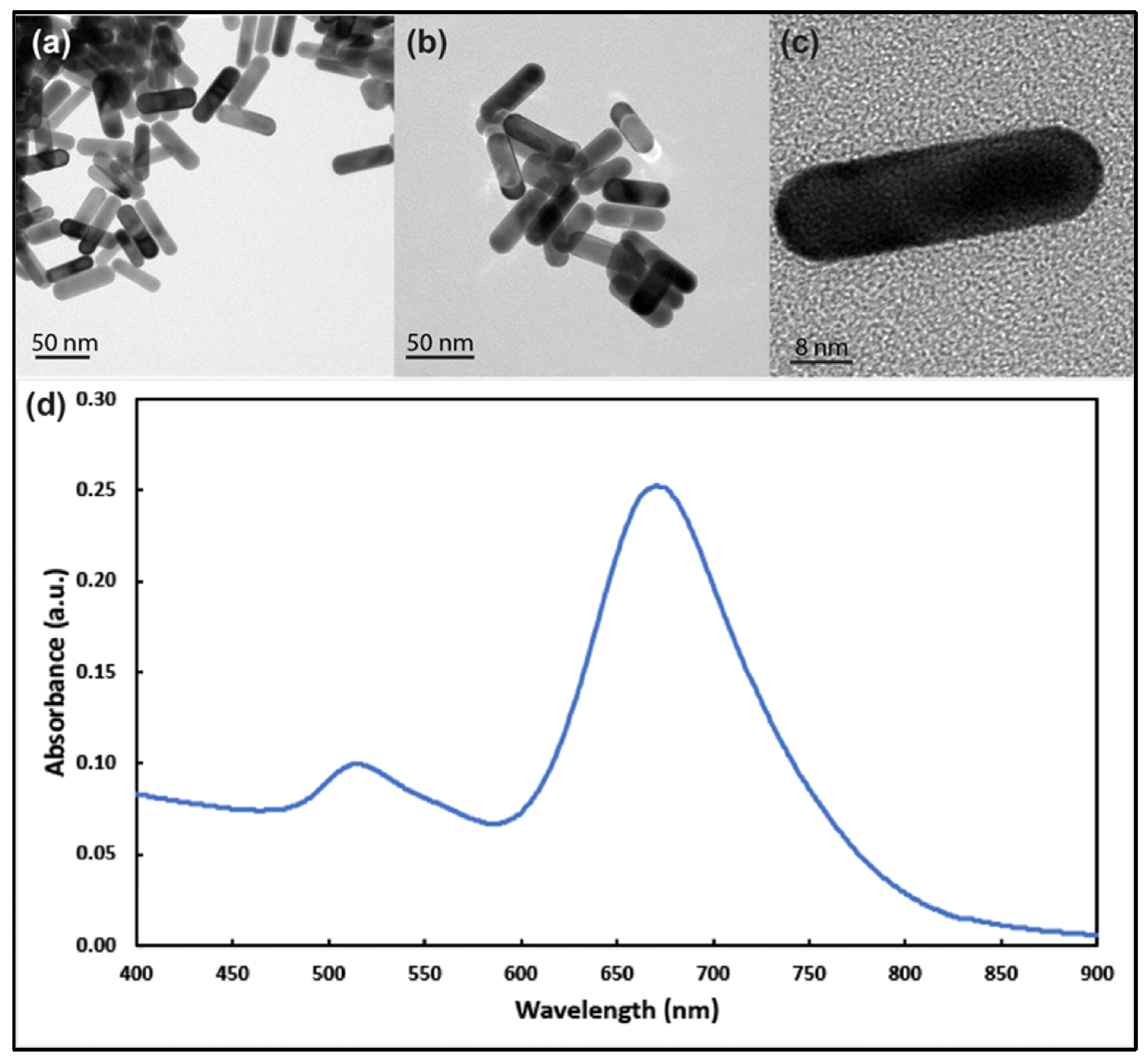
Figure 1. Transmission electron microscope images of gold nanorods with aspect ratio around 3 at different magnifications (a–c). (d) UV–visible spectrum analysis of the prepared gold nanorods showing longitudinal and transverse plasmons around 690 nm and 514 nm, respectively. © White, B., White, M., Nima Alsudani, Z., Watanabe, F., Biris, A., Ali, N., (2022)
About the Study
In this article, researchers investigated the interaction mechanism of gold nanorods (Au NRs) in two types of breast cancer cell lines namely, MCF-7 and SKBR-3. More than 200 Au NRs with an average length and diameter of 36 and 12 nm, respectively, were synthesized using the silver ion-assisted seed-mediated method. Subsequently, MCF-7 and SKBR-3 cells were cultured in a conducive medium and allowed to bind with different concentrations of Au NRs for 1 and 2 days.
The excess Au NRs were washed away from the treated cancels using phosphate buffer saline (PBS) solution followed by treating with the (3-(4,5-dimethylthiazol-2-yl)-2,5-diphenyltetrazolium bromide) (MTT) reagent. Finally, ICP-MS and TEM analyses were performed to investigate the interaction mechanism.
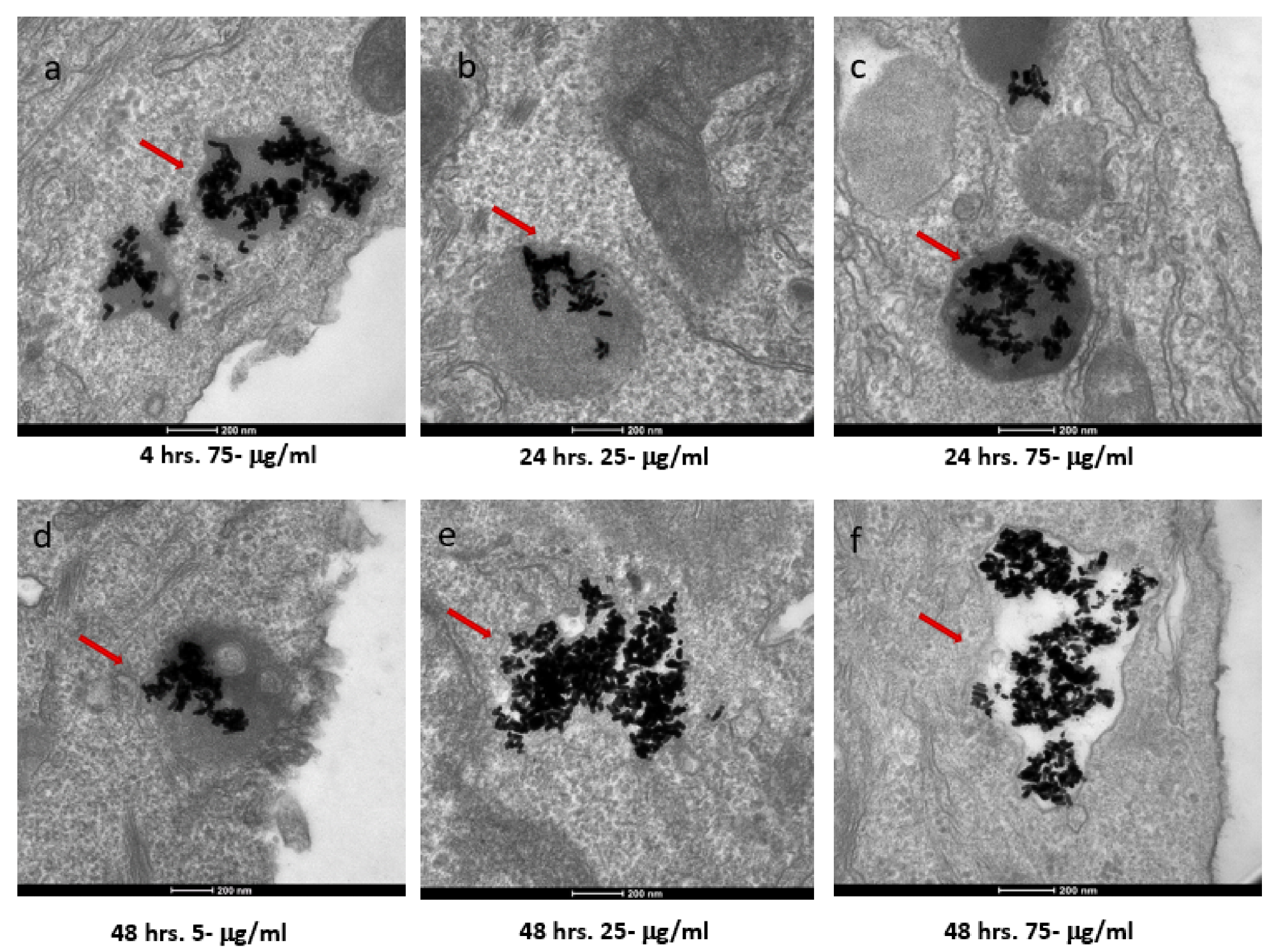
Figure 2. TEM images of AuNRs in SKBR-3 cells at different time points and concentrations. SKBR-3 cells were treated with 5, 25, and 75 μg/mL of AuNRs for 1, 4, 24, and 48 h. Internalization of nanorods was observed starting at 4hourincubation with 75 μg/mL (a). After 24hourof incubation, internalization was observed with the 25 μg/mL (b) and 75 μg/mL concentrations (c). For cells incubated for 48 h, we observed internalization with 5, 25, and 75 μg/mL concentrations (d, e, and f, respectively). Red arrows point to gold nanorods localized in SKBR-3 cells. Electron photomicrographs shown are representative of at least three independent experiments with similar conditions. © White, B., White, M., Nima Alsudani, Z., Watanabe, F., Biris, A., Ali, N., (2022)
Observations
TEM images showed Au NRs had longitudinal and transverse plasmon resonances at around 680 and 514 nm, respectively. The average zeta potential of the NRs was −47.18 ± 4.26 mV. Au NRs did not show any cytotoxicity in healthy human cells. MTT methods indicated that the MCF-7 cells were less sensitive to Au NR exposure than the SKBR-3 cells for longer exposure times at higher concentrations. The SKBR-3 cells exhibited a drop in cell vitality due to higher sensitivity, whereas the MCF-7 cells had almost no drop in cell viability.
Both types of cells demonstrated a different pattern in cellular uptake of Au NRs for different exposure times and concentrations. The SKBR-3 cells had a constant cellular uptake between one to four hours, but 25 μg/mL Au NRs concentration had a higher uptake than the 75 μg/mL sample, i.e. lower concentration had a higher cellular uptake. In contrast, in MCF-7 cells, the 75 μg/mL AuNR-treated cell samples exhibited higher cellular uptake than 5 and 25 μg/mL samples, i.e. higher concentration samples had higher cellular uptake than lower concentration samples.
Furthermore, TEM analysis showed that the Au NRs interacted with the cell membrane of both cancer cells starting from one to 48 hours of exposure time. However, the Au NRs entered into the cell (i.e. internalized) for the samples with concentrations of 25 and 75 μg/mL. The 5 μg/mL concentration samples were never internalized. Moreover, the minimum exposure time for internalization was one hour and four hours for the MCF-7 and SKBR-3 cells, respectively.
The mechanism for the cellular uptake of the Au NRs was primarily micropinocytosis instead of receptor-mediated endocytosis. These Au NRs-carrying macropinosomes further interacted with the lysosomes inside the cells.
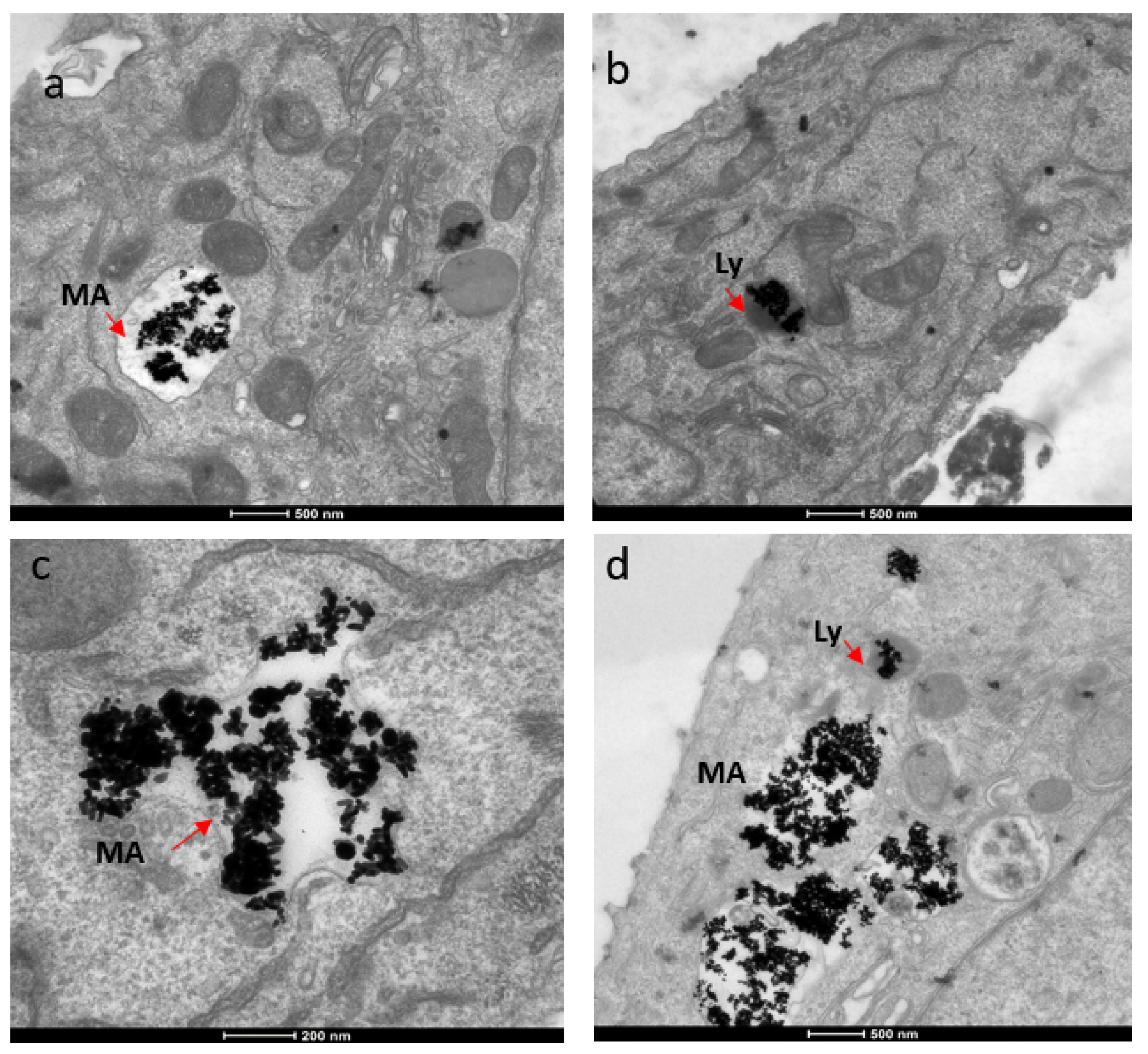
Figure 3. TEM images showing localization of gold nanorods in macropinosomes and lysosomes in both SKBR-3 and MCF-7 cell lines. AuNR localization in (a) macropinosomes (MA) and (b) lysosomes (Ly) of SKBR-3 cells. (c) Macropinosomes (MA) containing gold nanorods in MCF-7 and (d) lysosomes (Ly) containing gold nanorods in MCF-7. Red arrows point out macropinosomes and lysosomes containing gold nanorods in each image. Electron photomicrographs shown are representative of at least three independent experiments with similar conditions. © White, B., White, M., Nima Alsudani, Z., Watanabe, F., Biris, A., Ali, N., (2022)
Conclusions
To conclude, the researchers of this study investigated the interaction of Au NRs in two types of breast cancer cell lines, i.e. MCF-7 and SKBR-3. The shape, size, and zeta potential of Au NRs had different effects on cell vitality and toxicity of different cancer cells. Additionally, both cell types had different patterns of cellular uptake for Au NRs at different concentrations and exposure times.
The Au NRs did not enter into the cancer cells for samples with lower concentrations of NRs or lower exposure time. Also, the cellular uptake mechanism was primarily driven by micropinocytosis. These findings will help improve biomedical applications related to targeted drug delivery, tracing, and bio-imaging involving nanomaterials.
News
Researchers propose five key questions for effective adoption of AI in clinical practice
While Artificial Intelligence (AI) can be a powerful tool that physicians can use to help diagnose their patients and has great potential to improve accuracy, efficiency and patient safety, it has its drawbacks. It [...]
Advancements and clinical translation of intelligent nanodrugs for breast cancer treatment
A comprehensive review in "Biofunct. Mater." meticulously details the most recent advancements and clinical translation of intelligent nanodrugs for breast cancer treatment. This paper presents an exhaustive overview of subtype-specific nanostrategies, the clinical benefits [...]
It’s Not “All in Your Head”: Scientists Develop Revolutionary Blood Test for Chronic Fatigue Syndrome
A 96% accurate blood test for ME/CFS could transform diagnosis and pave the way for future long COVID detection. Researchers from the University of East Anglia and Oxford Biodynamics have created a highly accurate [...]
How Far Can the Body Go? Scientists Find the Ultimate Limit of Human Endurance
Even the most elite endurance athletes can’t outrun biology. A new study finds that humans hit a metabolic ceiling at about 2.5 times their resting energy burn. When ultra-runners take on races that last [...]
World’s Rivers “Overdosing” on Human Antibiotics, Study Finds
Researchers estimate that approximately 8,500 tons of antibiotics enter river systems each year after passing through the human body and wastewater treatment processes. Rivers spanning millions of kilometers across the globe are contaminated with [...]
Yale Scientists Solve a Century-Old Brain Wave Mystery
Yale scientists traced gamma brain waves to thalamus-cortex interactions. The discovery could reveal how brain rhythms shape perception and disease. For more than a century, scientists have observed rhythmic waves of synchronized neuronal activity [...]
Can introducing peanuts early prevent allergies? Real-world data confirms it helps
New evidence from a large U.S. primary care network shows that early peanut introduction, endorsed in 2015 and 2017 guidelines, was followed by a marked decline in clinician-diagnosed peanut and overall food allergies among [...]
Nanoparticle blueprints reveal path to smarter medicines
Lipid nanoparticles (LNPs) are the delivery vehicles of modern medicine, carrying cancer drugs, gene therapies and vaccines into cells. Until recently, many scientists assumed that all LNPs followed more or less the same blueprint, [...]
How nanomedicine and AI are teaming up to tackle neurodegenerative diseases
When I first realized the scale of the challenge posed by neurodegenerative diseases, such as Alzheimer's, Parkinson's disease and amyotrophic lateral sclerosis (ALS), I felt simultaneously humbled and motivated. These disorders are not caused [...]
Self-Organizing Light Could Transform Computing and Communications
USC engineers have demonstrated a new kind of optical device that lets light organize its own route using the principles of thermodynamics. Instead of relying on switches or digital control, the light finds its own [...]
Groundbreaking New Way of Measuring Blood Pressure Could Save Thousands of Lives
A new method that improves the accuracy of interpreting blood pressure measurements taken at the ankle could be vital for individuals who are unable to have their blood pressure measured on the arm. A newly developed [...]
Scientist tackles key roadblock for AI in drug discovery
The drug development pipeline is a costly and lengthy process. Identifying high-quality "hit" compounds—those with high potency, selectivity, and favorable metabolic properties—at the earliest stages is important for reducing cost and accelerating the path [...]
Nanoplastics with environmental coatings can sneak past the skin’s defenses
Plastic is ubiquitous in the modern world, and it's notorious for taking a long time to completely break down in the environment - if it ever does. But even without breaking down completely, plastic [...]
Chernobyl scientists discover black fungus feeding on deadly radiation
It looks pretty sinister, but it might actually be incredibly helpful When reactor number four in Chernobyl exploded, it triggered the worst nuclear disaster in history, one which the surrounding area still has not [...]
Long COVID Is Taking A Silent Toll On Mental Health, Here’s What Experts Say
Months after recovering from COVID-19, many people continue to feel unwell. They speak of exhaustion that doesn’t fade, difficulty breathing, or an unsettling mental haze. What’s becoming increasingly clear is that recovery from the [...]
Study Delivers Cancer Drugs Directly to the Tumor Nucleus
A new peptide-based nanotube treatment sneaks chemo into drug-resistant cancer cells, providing a unique workaround to one of oncology’s toughest hurdles. CiQUS researchers have developed a novel molecular strategy that allows a chemotherapy drug to [...]
